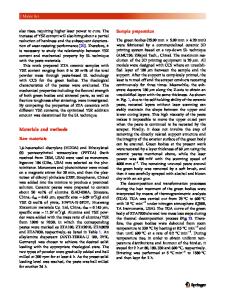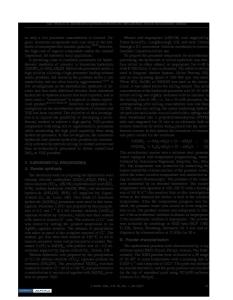Evaluation of Mechanical Properties of Stabilized Zirconia and Zirconate Pyrochlore
- PDF / 685,626 Bytes
- 19 Pages / 538 x 778 pts Page_size
- 93 Downloads / 382 Views
1043-T09-07
Evaluation of Mechanical Properties of Stabilized Zirconia and Zirconate Pyrochlore © 2008 Materials Research Society Takuya Matsuo*), Keiichi Shimamura, Tatsumi Arima, Kazuya Idemitsu and Yaohiro Inagaki Department of Applied Quantum Physics and Nuclear Engineering, Kyushu University, 744 Motooka, Fukuoka 819-0395, Japan E-mail*): [email protected]
Background Spent nuclear fuel Dismantled nuclear weapons
Plutonium MA (Minor Actinides)
© 2008 Materials Research • ReuseSociety as fuel • Transformation into short-lived nuclide
IMF (Inert Matrix Fuel) 1
Inert Matrix Fuel Stabilized zirconia (Er0.05Y0.1PuzZr0.85-zO1.925) and zirconate pyrochlore (An2Zr2O7 An=actinide) are candidate for the IMF. Characteristics of these IMF materials © 2008 Materials Research Society • High stability under irradiation • Extremely low rate of neutron absorption of zirconium • Geological and chemical stability • U free 2
Crystal structure Stabilized zirconia
Zirconate pyrochlore
Er0.05Y0.1PuzZr0.85-zO1.925
An2Zr2O7
© 2008 Materials Research Society Similarity Er,Y,Pu,Zr
Fluorite
An
Pyrochlore
Zr O 3
Objective Important properties as nuclear fuels
• Mechanical property (elastic moduli… ) • Thermal property (thermal conductivity, specific heat… )
© 2008 Materials Research • Characteristics under irradiation
Society
To evaluate elastic moduli for the system Er0.05Y0.1PuzZr0.85-zO1.925 and An2Zr2O7 by experimental and computational (MD simulation and ab initio calculation) approaches. 4
Experimental •Stabilized zirconia
Powder mixture or
Sol-gel method
Er0.05Y0.1CezZr0.85-zO1.925 (z=0.0, 0.05, 0.1, 0.15, 0.2) Cerium is surrogate for plutonium.
Pressure forming
Sintering (1400∼1600°C) © 2008 Materials Research Society
•Zirconate pyrochlore
Ln2Zr2O7 (Ln=La, Nd, Sm, Gd) Rare earth metals are surrogates for actinides.
Identification of structure X-ray diffraction analysis
Evaluation of elastic moduli Pulse-echo method 5
X-ray diffraction - stabilized zirconia -
X-ray intensity [a.u.]
Er0.05Y0.1Ce0.0Zr0.85O1.925 Er0.05Y0.1Ce0.05Zr0.8O1.925 Er0.05Y0.1Ce0.1Zr0.75O1.925
Fluorite
© 2008 Materials Research Society Er Y Ce Zr O 0.05
0.1
0.15
0.7
1.925
Er0.05Y0.1Ce0.2Zr0.65O1.925 20
40
60
80
100
2θ [degree]
These peaks are commonly observed for fluorite structures. Lattice parameter increased with Ce content. 6
X-ray diffraction - zirconate pyrochlore -
X-ray intensity [a.u.]
▼(331)
20
La2Zr2O7 ▼
(511)
Nd2Zr2O7 ▼
▼
Sm2Zr2O7 ▼
Pyrochlore
© 2008 Materials Research Society Gd Zr O ▼
2
▼
2
7
▼
40
60
80
100
2θ [degree]
Two peaks indexed (331) and (511) are originated from pyrochlore structure, other peaks are commonly observed for pyrochlore and fluorite structures. 7
Ultrasound Pulse-echo measurement Sample
Coupling agent Probe
Ultrasound
2L V= T
L
Incident wave © 2008 Materials Research Society V : Sound velocity
Pulse – receiver
T
L : Length of sample T : Time separation
Oscilloscope
Second reflected wave First reflected wave 8
Elastic moduli and
Data Loading...











